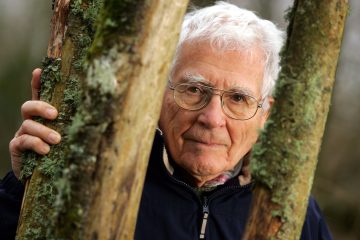Table of Contents
- Understanding James Lovelocks Gaia Theory and Its Implications for Climate Change
- The Role of Technology in Lovelocks Vision for a Sustainable Future
- Practical Steps Inspired by Lovelock to Combat Climate Change
- The Importance of Diverse Ecosystems in Lovelocks Climate Perspective
- Engaging Communities: Lovelocks Call to Action for a Collective Response to Climate Crisis
- Q&A
- Wrapping Up
Understanding James Lovelocks Gaia Theory and Its Implications for Climate Change
James Lovelock’s Gaia Theory posits that the Earth functions as a self-regulating, complex system where living organisms and their inorganic surroundings are co-dependent. This radical idea suggests that life on Earth actively maintains conditions suitable for its survival, creating a feedback loop between the biosphere and the geophysical environment. Understanding this concept can profoundly reshape our perspective on climate change, urging us to see it not merely as an environmental issue but also as a systemic global crisis. The implications of this theory suggest that every action we take reverberates throughout the ecosystems we inhabit.
Among the key elements of Lovelock’s theory are:
- Interconnectedness: All life forms are intricately linked, meaning that the degradation of one part of the system can lead to widespread consequences.
- Homeostasis: The planet has mechanisms to regulate its own climate, but human activities are disrupting these natural processes.
- Resilience: While the Earth is resilient, it can only absorb a certain level of disruption before it shifts into a less hospitable state.
By recognizing the Earth as a living entity, we are called to reconsider our role in its stewardship. This perspective encourages us to adopt a more sustainable approach to life, emphasizing the importance of reducing carbon footprints and promoting biodiversity. As we confront climate change, Lovelock’s insights remind us that the health of the planet relies on the synergy between human actions and natural equilibria. Understanding this relationship is crucial for developing effective strategies to combat climate change and restore balance to our shared home.

The Role of Technology in Lovelocks Vision for a Sustainable Future
James Lovelock’s vision for a sustainable future revolves significantly around the integration of advanced technologies that can help humanity adapt to the challenges posed by climate change. His concept of the Gaia hypothesis emphasizes the interconnectedness of all living organisms and their physical environment. To realize this vision, technology plays a pivotal role in enhancing our understanding of ecological systems, enabling us to respond proactively to environmental threats. Key technologies influencing this transition include:
- Renewable Energy Solutions: Innovations in solar energy, wind power, and bioenergy are crucial for reducing our dependency on fossil fuels.
- Smart Agriculture: Precision farming techniques utilize data analytics and IoT devices to maximize crop yields while minimizing resource use.
- Sustainable Materials: Development of biodegradable plastics and sustainable building materials contributes to a circular economy, reducing waste and pollution.
Moreover, Lovelock advocates for technologies that enhance our ability to monitor and predict environmental changes. Tools such as satellite imagery and AI-driven data analysis provide real-time insights into climate patterns, allowing for more effective decision-making. Additionally, the use of biotechnology can foster resilience in ecosystems, as genetic engineering offers solutions to challenges like pest resistance and climate adaptation. These advancements not only streamline our activities but also pave the way towards a more symbiotic relationship with nature. Below is a table summarizing the prominent technological advancements and their potential benefits:
| Technology | Key Benefits |
|---|---|
| Solar Panels | Reduce carbon footprint and provide clean energy. |
| Vertical Farming | Maximizes land use and cuts down on water usage. |
| AI and Machine Learning | Improves efficiency in resource management and data analysis. |
Lovelock’s forward-thinking approach emphasizes not only the need for sustainable practices but also the crucial role of technology in achieving these goals. By harnessing innovation, we can drive meaningful change that aligns with the rhythms of nature and safeguards our planet for future generations. The collective effort in adopting these technologies signifies a progressive step towards a resilient and sustainable future.

Practical Steps Inspired by Lovelock to Combat Climate Change
James Lovelock’s innovative ideas on climate change encourage us to adopt practical solutions that can make a significant impact. He emphasizes the importance of understanding our planet as a complex ecosystem—an interconnected web where every action has a reaction. To contribute effectively to the fight against climate change, individuals and communities can integrate the following practical steps into their daily lives:
- Adopting Renewable Energy: Transitioning to solar, wind, or other renewable energy sources reduces dependency on fossil fuels, which are major contributors to greenhouse gas emissions.
- Enhancing Local Biodiversity: Supporting local wildlife and planting native species helps create a more resilient ecosystem that can better withstand the effects of climate change.
- Promoting Sustainable Agriculture: Utilizing organic farming techniques and reducing chemical inputs not only preserves soil health but also protects water resources.
Lovelock’s Gaia theory presents an insightful framework for understanding the balance of nature. Communities inspired by this concept can implement initiatives that focus on restoration and conservation. Strategies might include:
| Initiative | Description |
|---|---|
| Urban Reforestation | Planting trees in urban areas to improve air quality and reduce heat. |
| Water Conservation Programs | Implementing rainwater harvesting and efficient irrigation systems. |
| Community Clean-Up Drives | Organizing local efforts to clean up natural habitats and public spaces. |
Ultimately, the shift toward a more sustainable society inspired by Lovelock’s insights involves not just personal responsibility, but also collective action. Collaboration among community members, businesses, and governments can enhance the effectiveness of these strategies. Engaging in policy advocacy to support environmental regulations or participating in local climate action groups can significantly amplify individual efforts, creating a larger ripple effect in the battle against climate change.

The Importance of Diverse Ecosystems in Lovelocks Climate Perspective
Diverse ecosystems play a crucial role in maintaining the delicate balance of our planet’s climate, a perspective that aligns closely with James Lovelock’s Gaia Theory. Lovelock posits that life interacts with the Earth’s geology and atmosphere to create a self-regulating system. When ecosystems thrive in diversity, they establish resilient networks that can better withstand environmental changes and crises. This adaptability is paramount in a time where climate fluctuations are becoming increasingly pronounced, underscoring the inherent value of biodiversity.
Healthy ecosystems contribute significantly to climate stabilization through various mechanisms, such as:
- Carbon Sequestration: Forests, wetlands, and grasslands capture and store carbon dioxide, helping to mitigate the effects of climate change.
- Water Regulation: Diverse ecosystems enhance water quality and availability, playing a vital role in local and global hydrological cycles.
- Soil Health: Rich biodiversity in soil microorganisms leads to improved soil structure and fertility, which are crucial for agricultural resilience amidst climate challenges.
Moreover, the interdependence found in diverse ecosystems ensures the survival and proliferation of species, which are key to ecological balance. A decline in species richness can lead to ecosystem collapse, significantly impacting climate regulation. For instance, the disappearance of pollinators disrupts food production, while the loss of certain flora can reduce carbon storage capabilities. To visualize these relationships, consider the following table:
| Aspect | Impact of Diversity |
|---|---|
| Carbon Sequestration | Increases with diverse plant species, capturing more CO2 |
| Soil Stability | Diverse organisms improve soil structure, preventing erosion |
| Biodiversity Resilience | Greater variety means better recovery from disturbances |
By embracing and preserving diverse ecosystems, we enhance our capacity to combat climate change effectively. The intricate relationships within these environments not only sustain the planet’s health but also empower us to create sustainable solutions for the future. The notion of protecting biodiversity aligns perfectly with Lovelock’s vision of a synergistic relationship between life and the Earth, illustrating the profound impact diverse ecosystems have on climate stability.

Engaging Communities: Lovelocks Call to Action for a Collective Response to Climate Crisis
As the urgency of the climate crisis intensifies, the call for a united community response has never been more critical. James Lovelock’s insights remind us that we are not just inhabitants of this planet but interconnected stewards of its future. By fostering a collective approach, communities can mobilize resources, share knowledge, and implement strategies that resonate with Lovelock’s vision of Earth as a delicate, self-regulating system. The challenge lies in transforming individual frustrations into actionable community initiatives that make a tangible difference.
To catalyze this movement, communities can adopt several initiatives that align with Lovelock’s principles:
- Local Workshops: Organize gatherings that educate residents on sustainable practices.
- Digital Platforms: Create online forums for discussing environmental challenges and solutions.
- Community Gardens: Establish shared spaces for growing food, promoting biodiversity, and reducing carbon footprints.
- Renewable Energy Projects: Initiate collaborations to install solar panels or wind turbines, enhancing local energy resilience.
Moreover, leveraging data can bolster these initiatives. Below is a brief overview of impactful statistics that reinforce the necessity for community engagement:
| Statistic | Impact |
|---|---|
| 50% of the world’s population lives in urban areas | Urban communities significantly influence climate policy and resource consumption. |
| 15% reduction in waste through community recycling programs | Collaborative efforts can lead to visible change and a culture of sustainability. |
| Over 1 billion people are engaged in grassroots environmental movements | Collective advocacy can prompt policy shifts at national and global levels. |
Q&A
Q&A on James Lovelock and Climate Change
Q: Who is James Lovelock? A: James Lovelock is an English scientist, environmentalist, and author widely recognized for his contributions to environmental science. Born in 1919, he is best known for developing the Gaia hypothesis, which posits that the Earth functions as a self-regulating system, with living organisms interacting with their inorganic surroundings to maintain the conditions necessary for life.Q: What is the Gaia hypothesis? A: The Gaia hypothesis suggests that the Earth and its biological systems behave as a single entity, or “superorganism.” According to Lovelock, life on Earth influences environmental conditions, such as climate and chemistry, in ways that sustain and promote life. This groundbreaking concept encourages a holistic view of ecology, emphasizing the interconnectedness of all life forms and their environments.
Q: How has Lovelock contributed to our understanding of climate change? A: Lovelock’s work has been instrumental in shaping public discourse on climate change. He was among the first to articulate the potential impact of human activities on global climate systems. His research into the interaction between carbon dioxide levels and Earth’s climate has highlighted the importance of understanding these dynamics to predict future climate scenarios and guide mitigation strategies.
Q: What are some of Lovelock’s predictions for the future of our planet? A: Lovelock has expressed concerns about the future of the Earth under the influence of climate change. He predicts significant environmental shifts, including rising sea levels, increased frequency of extreme weather events, and challenges to food security. He emphasizes the urgency of reducing greenhouse gas emissions and addressing climate change to prevent catastrophic consequences.
Q: What solutions does Lovelock propose for combating climate change? A: Lovelock advocates for a variety of solutions, including geoengineering—deliberate modification of the Earth’s environment to counteract climate change—alongside renewable energy adoption and sustainable agricultural practices. He believes that humanity must embrace innovative technologies and strategies while also fostering a deeper respect for the natural world.
Q: How does Lovelock’s perspective differ from mainstream environmentalism? A: While many environmentalists focus on conservation and sustainable practices to combat climate change, Lovelock’s approach is often seen as more radical. He proposes that humans may need to accept a role as active managers of Earth’s systems rather than mere stewards. His views have sparked debate within the environmental community, challenging traditional narratives and encouraging new methodologies.
Q: What legacy does Lovelock leave behind? A: James Lovelock’s legacy is one of profound influence on the fields of ecology and environmental science. His Gaia hypothesis has reshaped our understanding of Earth’s biosphere, while his candid discourse on climate change has inspired generations of scientists, policymakers, and activists. Lovelock’s work continues to be a catalyst for dialogue and action in addressing the urgent challenge of climate change.—This Q&A format serves not only to define key aspects of James Lovelock’s influence on climate discourse but also to engage readers in a conversation about significant environmental issues.



0 Comments